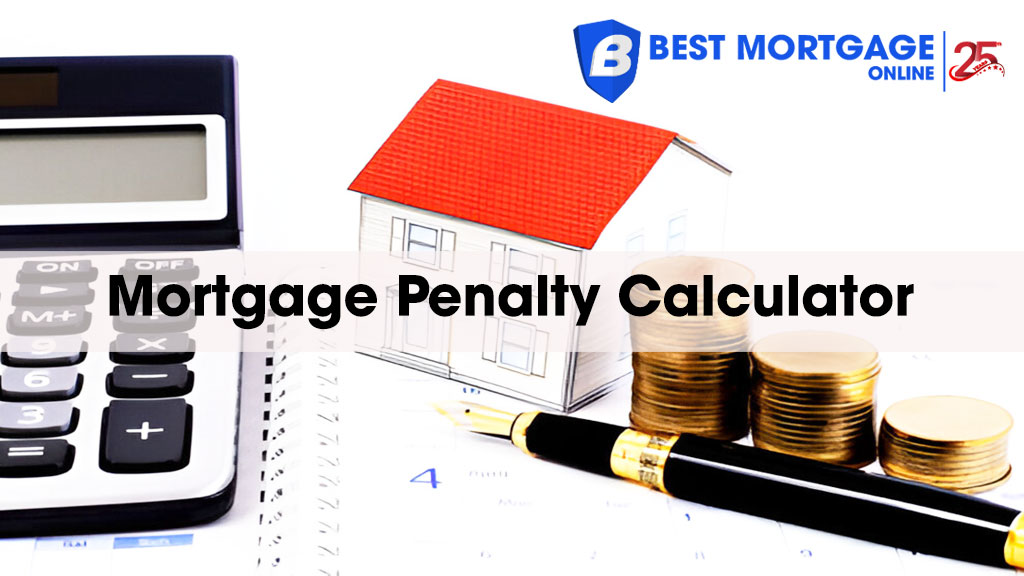Breaking a mortgage contract before the end of its term often results in prepayment penalties charged by the lender. Use our mortgage penalty calculator to estimate costs before locking in your decision.
What is a mortgage penalty?
A mortgage penalty, also known as a prepayment charge, is a fee that lenders charge when borrowers break the terms of their mortgage agreement, including:
- Pay more than the annual prepayment limit set out in the mortgage contract
- Pay off the entire mortgage before the end of its term, or sell the home
- Refinance the mortgage with the same lender or a new lender
The amount of penalties you pay depends on:
- Interest rate
- The prepayment amount
- The remaining time of the term
- And the lender’s calculation methods when determining costs for breaking the contract early.
Canadian financial institutions have developed standardized methods for these calculations, though each lender applies slightly different formulas and considerations.
How is a mortgage penalty calculated?
Mortgage penalties are calculated differently depending on whether you have a variable or fixed mortgage rate. The formulas used by specific lenders also impact penalty amounts.
Variable-rate mortgage penalty
The most common method for calculating variable-rate mortgage penalties is the “3 Months Interest Penalty”. This straightforward method charges 3 months of interest on the mortgage balance based on your current rate.
The formula for the 3 Months Interest Penalty: (Mortgage balance x Interest rate) / 12 x 3
Some lenders use your current mortgage rate, while others base it on their prime rate when determining the interest portion.
| Lenders use your current rate | Lenders use their prime rate |
|---|---|
| RBC TD Bank Scotiabank National Bank MCAP First National Equitable Desjardins Tangerine Manulife … | CIBC People Bank Laurentian Bank (use the higher of your mortgage rate and prime rate) … |
Additionally, for variable mortgages, some lenders, particularly on low-rate or niche mortgage products, charge a penalty equal to a set percentage of your mortgage balance. For example, the penalty for breaking a $300,000 balance with a 2.9% penalty rate equals: $300,000 × 0.029 = $8,700.
This method provides certainty but can result in substantial penalties.
Fixed rate mortgage penalty
Fixed rate mortgage penalties are typically higher. Lenders typically charge the greater of:
- 3 months’ interest
- Interest Rate Differential (IRD) penalty
The IRD calculation represents the financial industry’s method for recovering lost interest revenue.
Each lender has their own IRD calculation methods, with the most commonly used types being:
- Standard IRD Penalty: This method is primarily used by mortgage finance companies and virtual lenders, which compares your mortgage rate with their closest posted rate for the remaining term length.
- Discounted IRD Penalty: Banks use an adjusted version called the Discounted IRD, which factors in the original discount you received off their posted rate when your mortgage started. This makes it the most expensive penalty calculation method.
| Lenders use the standard IRD penalty | Lenders use the discounted IRD penalty |
|---|---|
| MCAP First National Tangerine Manulife … | CIBC RBC TD Bank Scotiabank Peoples Bank Laurentian Bank Desjardins Equitable (depends on the mortgage product) CMLS … |
The IRD calculation, which compensates lenders for interest losses when current rates are lower than the original rate, usually ends up being the greater amount.
Since mortgage penalties vary across different lenders in Canada, use our penalty calculator to estimate your costs.
Are there limits on mortgage penalties in Canada?
The federal Interest Act provides some protection by capping penalties at 3 months’ interest after 5 years from the mortgage start date. However, penalties can still be uncapped in the first 5 years, except in cases involving the bona fide sale of a property.
Certain provinces have additional consumer protection regulations around maximum mortgage penalties. Requirements vary regionally regarding penalty caps and the calculation methods lenders must use.
How does the stress test affect breaking your mortgage?
Canada’s mortgage stress test significantly impacts your options when breaking your mortgage.
If you remain with your current lender, no stress test is required for renewals or switches.
However, if you switch to a new lender, new applications require passing the stress test at the greater of:
- Your contract rate plus 2%
- The Bank of Canada qualifying rate (currently 5.25%)
This requirement can disqualify borrowers with reduced income or increased debt since their original approval.
Can you avoid mortgage prepayment penalties?
While it can be challenging to avoid penalties when breaking a closed mortgage, the following strategies can help minimize costs:
- Stay within your annual prepayment limits
- Port your mortgage to a new property
- Blend and extend your remaining mortgage term
- Wait for your renewal period
- Opt for open mortgages which allow prepayments without penalties
FAQs related to Mortgage Penalty Calculator
Do all Canadian mortgages have prepayment penalties?
Only closed mortgages carry prepayment penalties. Open mortgages allow unlimited prepayments without penalties but charge premium interest rates for this flexibility.
How can i calculate my exact penalty?
Contact your lender directly for precise calculations. Provide your account number, remaining balance, and intended prepayment date. Online calculators offer estimates but may not reflect your specific contract terms.
Can I negotiate my mortgage penalty?
Limited negotiation opportunities exist. Lenders occasionally waive portions of penalties for long-standing clients or when switching to another product within their institution.
Should i pay the penalty or wait?
Calculate your break-even point by dividing total costs (penalty plus fees) by monthly savings. If break-even occurs within 18-24 months, breaking often proves beneficial.
The bottom line
This guide outlined key calculation methods used by lenders nationwide to determine prepayment charges. Use our mortgage penalty calculator to estimate fees specific to your situation easily.
Before finalizing any decision to break your mortgage, be sure to connect with a professional advisor to ensure that breaking makes long-term financial sense based on your circumstances.




